Definition of a plant cell
They are multicellular, eukaryotic cells which comprise the Plant (a collection of eukaryotes that belong to the Plantae kingdom ) capable of producing their own food from sunlight, water and carbon dioxide). Since they are eukaryotic they possess a distinct nucleus, with specially designed organelles that allow them to function in a controlled way.
The plant cell has a clearly defined cell wall that is composed of cellulose, plastids which carry out photosynthesis, and also store carbohydrates in the form in starch. There are also central vacuoles responsible for controlling the cell’s turgor pressure and a nucleus that controls the general mechanism of the cell which include reproduction of the cell’s.
General features of plant cell
Plants are comprised of two systems of structure i.e the shoot system and the root system. it is comprised of structures, which are above ground, including stems, leaves, and flowers, while roots are composed of tubers, roots, and rhizobial structure which lie below the soil and are the source of growth for plants.
They are organized differently, and are characterized by specialized mature cells that carry out various functions that range from protection, support metabolism, reproduction, development and growth. Plant cells form at the meristem, which multiply and develops into tissue of the plant. The tissues include:
- Dermal tissue – Dermal tissue is located on the plants’ surface and is composed of epidermal cells, which help safeguard the plants from losing water.
- Ground tissue – Ground tissue forms the epidermal and root vascular system that is mostly composed of collenchyma, parenchyma and sclerenchyma cell types that perform photosynthesis in plants, the storage of food and water and the plant’s support system.
- Vascular Tissue – this tissue is composed of xylem and phloem cambium, and parenchyma cells which performs functions such as transport of fluids (xylem) and transportation for food (phloem) hormones, minerals and plants.s of plant cells.
Cells of plants multiply through division, a process called Mitosis that takes place in the nucleus of the cell. The process begins in the meristem, which is located at the end of the root, and/or on the shoot of the vascular plants. Meristems that are located near the tip are called apical as well as laterally Meristems. Apical meristems play a role in making the roots. The lateral meristems create secondary growth of cork and stem wood.
In addition to the division of cells, which leads to the creation of tissues which eventually form plants and a plant, there are additional characteristics of plant cells which are crucial for the growth of plants and their metabolism.
- The presence of a cell wall that is surrounded by the plasma membrane. It’s composed of hemicellulose, cellulose and pectin. The cell wall provides the shape of the cell, as well as protection and mediation of cell interactions.
- They possess single-membranous, dynamic central vacuoles which contain water in order to keep the turgor pressure in the cell. They also regulate the movement of cells’ molecules in the cytosol, the storage and transport of nitrogen as well as phosphorus, and aid in digestion of stored cell proteins.
- They also have plasmodesmata it is a continuous, porous structure that extends out from the endoplasmic-reticulum, which allows cell-cell communication.
- Plant cells also contain plastids. The most well-known plastid is known as chloroplasts consist of chlorophyll which is a color that is green. It’s that is responsible for capturing light energy and converting it into chemical energy which is then utilized by plants to produce photosynthesis. Other plastids are amyloplast for starch storage as well as elaioplast to store of fats, and chromoplasts that are used for the storage and synthesis of pigments.
- Plant cells undergo cell division through making the phragmoplast template that is used for making cell plates for the process of cytokinesis.
- In contrast to animal cells, plant cells are notably devoid of flagella, cilia, and centrioles.
Types of Plant Cell
As mentioned above plants originate from the tips of plant’s roots. The growth of other cells is assisted through the initial multiplication process which occurs at the tip from the meristematic cells that are not differentiated to develop into various specialized cells as well as cell tissues. These comprise:
- Parenchyma cells
- Collenchyma cells
- Sclerenchyma cells
- Xylem cells
- Phloem cells
- Meristematic cells
- Epidermal cells
1. Parenchyma cells
- These cells are live and undifferentiated located in various places on the plant’s bodies.
- They play a role in various aspects of the plan such as photosynthesis and food storage as well as the release of waste substances.
- The experiment showed that they appear to be green.
Structure of parenchyma cells
They are living cells with thin walls with permeable walls and remain undifferentiated. They don’t have specific structure, so they can easily change and transform into various cells with different functions. There are two kinds of parenchyma cells.
- Palisade parenchyma: Palisade parenchyma cells form columnar elongated cells found in various of leaves. They are located below the epidermal layer. Palisades are closely connected cells within mesophyll layers cells within leaf cell.
- Ray parenchyma: Ray parenchyma is a horizontal and radial arrangements that are located in the woody stem of plants.
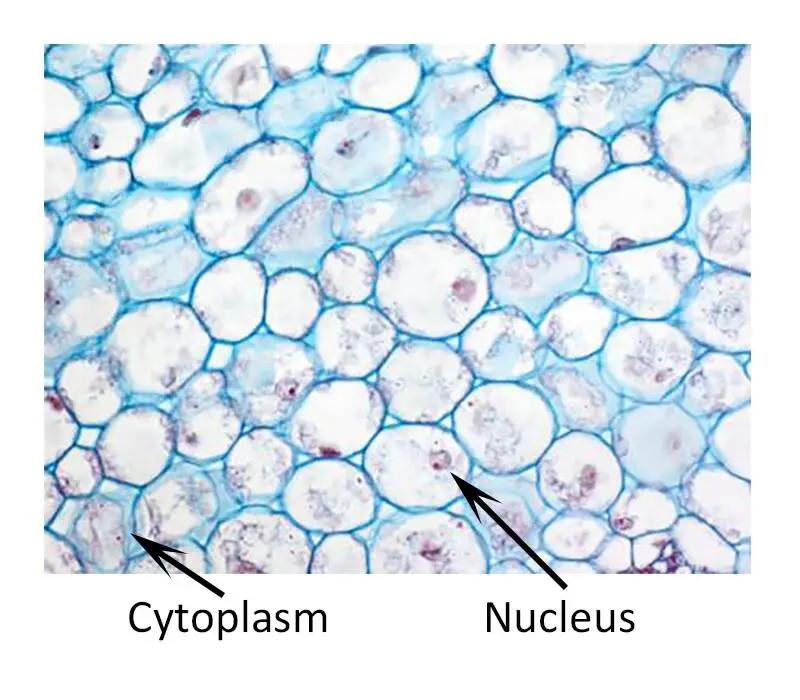
Functions of the Parenchyma cells
- Parenchyma cells are tightly linked to epidermal surface cells which are a major contributor to light absorption and penetration as well as controlling gas exchange.
- Permeable walls allow small molecules to move between cells and cell’s the cytoplasm.
- The palisade parenchyma, when combined with mesophyll cells that are spongy under the layer of epidermis tissue helps in the absorption of light that is used for photosynthesis.
- Ray parenchyma cells can be found in wood rays, which carry material along the plant stem.
- Parenchyma cells can also be present in large numbers within the xylem as well as the phloems of plants that are vascular which aid in the movement of food and water within the plant.
- They also participate in the biochemical production of nectar as well as the production of secondary elements that serve as protection materials against herbivores’ food.
- Parenchyma cells, which are located in root tubers, like potatoes, leguminous plant, assist in the storage of food.
2. Collenchyma cells
- They are elongated cells that can be found under the epidermis or in young plants, on the outer layer of their leaves and stems.
- They come back to life after maturing into a form that is derived from the meristems. They are located in the vascular or on the stem corners of the plant.
- They are located in the peripheral regions of the plant. They are not present in the roots of the plant.
- Experimentally, they appear to be red.
Structure of collenchyma cells
- Cells are long and have the cell’s primary wall being thick. The cell’s wall is typically uneven and is composed of pectin and cellulose.
- At an age, they begin to resemble the parenchyma cells that transform into collenchyma cells. When cells begin to accumulate in the Golgi body, the Golgi bodies along with the endoplasmic-reticulum join and form the primary wall of the cell. When two cells join together, they create an extremely thin wall that doesn’t differentiate into collenchyma cells.
- Thus, the more cells enlarge as they fuse create a robust, irregular principal cell wall. These newly formed cells get stretched out to support the plant to develop. But the primary wall does not contain lignin. It is which is a polymeric organic compound that creates strong structural tissues in plants that provide support, particularly in bark and wood, and prevents decay.
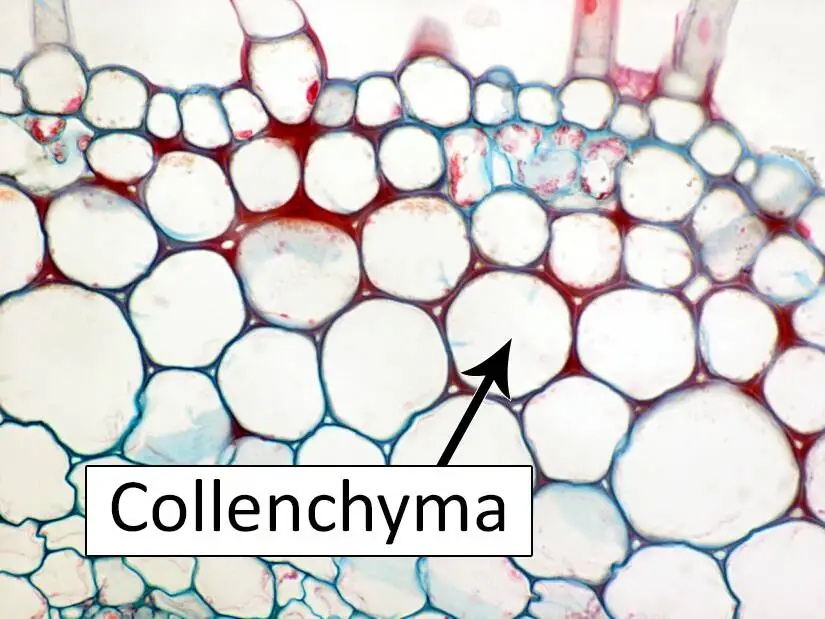
Types of collenchyma cells
There are four kinds of collenchyma, based on the wall’s thickness and the arrangement of cells
- Angular collenchyma
- Annular collenchyma
- Lamellar collenchyma
- Lacunar collenchyma
Angular collenchyma
- They appear to be angled and a polygonal form.
- The cells are thickened around the corners of cells.
- The cells don’t have intracellular spaces because they are tightly packed
- They are located beneath the epidermis and are referred to as hypodermis.
- These are among the commonly used kind of collenchyma.
Annular collenchyma
- The walls are evenly thickened.
- The cells appear circular in form.
Lamellar collenchyma
- The cells are thickened along the perimeter, creating them to appear tangentially placed in rows
- They are tightly joined and do not have intracellular space.
- They are usually created and are found in the petioles of leaves.
Lacunar Collenchyma
- Cells are created in a way that is large enough to leave spaces between cells.
- The cell wall gets thicker around intracellular spaces.
- They appear to be spherically formed
- They are formed and can be found inside the fruit’s walls
Functions of the Collenchyma cells
- Since they are living cells in the plant tissues, they provide support to plant parts which are maturing and growing in length. Because the cell wall is devoid of an amino acid called lignin, it stays flexible, giving plants parts such as younger stems and roots and leaves that are young with plastic (stretchable) to support.
- They provide flexibility and tensile strength for tissue of plants, allowing plants to be bent.
- They also allow parts of the plant to expand and lengthen.
- Collenchyma is able to combine with the chloroplast to perform the photosynthesis process.
3. Sclerenchyma cells
- They are collenchyma cell types that contain an agent in the cell wall which is a key factor in the process of hardening the cell wall.
- Thus, they are mature Collenchyma cells that have secondary cell walls, above the cell’s primary wall.
- They are present in all root systems of plants and they play a crucial role in anchoring and providing support to plants.
Structure of sclerenchyma cells
- They have a cell wall that is lignified which makes them extremely tough.
- These cells are more rigid than the collenchyma as well as the parenchyma cells.
- They also contain cutin and suberin that making them waterproof.
- Due to their rigor and waterproof effects Due to their rigidity and waterproof effect, they don’t last long as they is no way to exchange material for the cellular metabolism to ensure their longevity.
- So, in the event of reaching their full functional maturation (a stage of cytoplasm formation) the cells are dead.
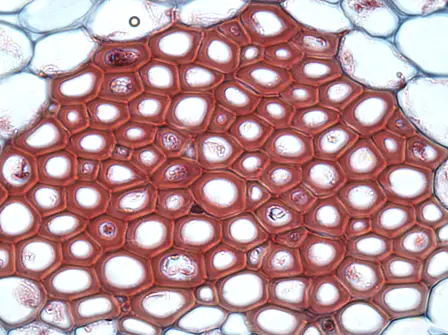
Types of sclerenchyma cells
There are two types of sclerenchyma cells
- Fiber sclerenchyma cells
- Sclereid sclerenchyma cells
Functions of the sclerenchyma cells
- Because of their thickened cell wall they provide protection and strength to the tissues of other plants, particularly the trunks of trees and the fibers of larger herb trees.
- The hardened cell wall deters herbivores. Consumption of the cell wall that is hard damages stomach tracts that feed the larval stage insect specifically in peach fruits.
- Sclerenchyma fibers are utilized in the production of fabric, thread and yarns.
4. Xylem Cells
Cells called Xylem are intricate and that are found in the tissue of the vascular system of plants most often in woody plants.
Structure of Xylem cells
- There are two components that allow conducting: Tracheids and vessel elements
- They have tracheids that are vessels that carry minerals and water from the roots, to the leaves of plants.
- Tracheids are elongated, slender vessels that are lignified so they have a hardened secondary cell wall, which is designed to carry water away from roots.
- The tracheid also has two overlapping tap ends that are placed in an angel position to allow the connection and transmission between cells.
- The vessel components permit the transportation of water. The hollow vessels are smaller and longer and wider than the tracheids however they don’t have angeled endplates so they are aligned with one another to form a hollow tube that is 3 meters long.
- The xylem cells are joined by fibers and parenchyma cells. They have a cell wall that is primary together with a lignified cell wall, which forms loops and looped networks that have pits referred to as conduction pits bordered.
- The pits bordered by borders are the areas inside the cell wall where the cell wall’s primary materials are laid down, and allow water to circulate between the cells of the xylem.
- Gymnosperms, ferns and Pteridophytes are tracheid-like, while flowering plants possess vessels.
Functions of the xylem cells
The main function of cells in the xylem is transporting water, soluble minerals as well as inorganic ions and minerals upwards from the roots of plants as well as its components. They move freely through the xylem tracheids as well as vessel elements thanks to the help of the sap of the xylem.
5. Phloem Cells
- These cells are found just outside the xylem layers of cells. They are alive when they reach age of maturity due to the energy required to move material.
- They are responsible for transporting food particles from the plant leaves to the other parts in the plants.
- Also, their cells are flaccid. membrane which means they have a weak tensile force which allows them to move objects under high pressure.
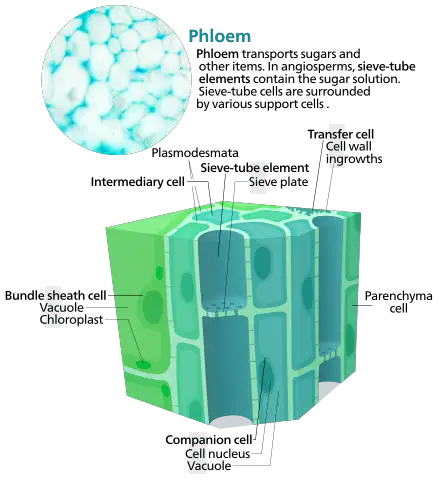
Types of phloem cells
There are two kinds of phloem cell:
- Sieve tube members and Companion cells
- Sieve cells
Sieve tubes and Companion cells
- They are the cells responsible for the metabolism of cells and they are interconnected by a large number of plasmodesmata.
- The sieve tube members are smaller and larger, and are continuously placed from one end inside the sieve cells which are compacted.
- This lets the solutes accelerate their movement within the tubes and in the cells of the sieve. The members of the sieve tube’s nucleus is destroyed, ribosomes vanish, as well as the membrane of vacuoles break down when it reaches maturity.
- The cells that are part of the companion system help in the movement of materials through and out of members of the sieve tube. In particular, the sieve tubes are characterized by Phloem (P)-proteins on the cell’s walls and callose. Together, they repair the damage caused by sieve tubes.
Sieve cells
- They are the most primitive component of the phloem that is found in conifers and ferns.
- These are structurally lengthy, with tapered ends that overlap. They are pore-filled throughout their cell walls that are enclosed by the chemical callose (a carbohydrate which repairs the pores following injury).
- They are able to collaborate with albuminous cells and aid in the movement of materials through the ploem.
- This is the place where food that is dissolved flows, for example sucrose.
Functions of the phloem cells
It is able to transport dissolved food and organic material throughout plants due to its capability to move these substances throughout the plant, contingent on the nature and the age of the plant.
6. Meristematic cells
- They are also referred to as the Meristems.
- These are cells within the plant that continue to divide throughout the lifespan of the plant.
- They possess a self-renewal capability and high metabolic rate to regulate the cell.
Structure of the meristematic cells
- They undergo cell division and give birth to the Collenchyma, Parenchyma and Sclerenchyma cells.
- They have a thin wall and do not have the central vacuole. They consist of impermanent plastids.
- Their protoplast is incredibly full.
- They are cubic in shape and a big nucleus.
- They have a high metabolic rate
- They are tightly clamped together and, as a result, do not have intercellular space.
- They play an important part in the growth of plants in both length and width.
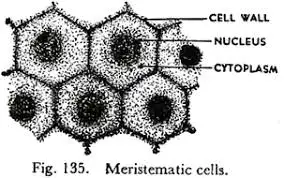
Types of meristematic cells
There are three kinds of meristematic cell types classified by the type of tissue they reside in.
- Apical meristems – Apical meristems are located at the ends of stems and roots which have begun to grow and they play a role in growing the entire length.
- Lateral meristems – Lateral meristems can be located in the radial portion of the stem and the roots and are a major contributor to plant’s the thickness.
- Intercalary meristems – Intercalary meristems are located at the base of the leaves. They also make an impact on the size variation of leaves.
Functions of the meristematic cells
- They play an important impact on the length and width of the plants.
- They also differ in the size of the leaves.
- They develop and transform in permanent cells of plants.
7. Epidermal Cells
- They are the cells that extend outside of the plant that protect from loss of water, pathogenic invaders like fungi.
- They are positioned close together without any intracellular space.
- They are encased in waxy cuticle layers to stop the loss of water.
- The cells are covered by plant stems, leaves, root and seeds of the plant.
Types of epidermal cells
There are three kinds of epidermal cells which perform the main role in protecting plants from environmental elements such as high temperatures, pathogensand and chemical exposures e.g. radiations. These include:
- Pavement cells
- Stomatal guard cells
- Trichomes
Structure and Functions of Epidermal Cells
Pavement cells
- These are the most commonly used epidermal cells found in all plants. They’re not specialized enough, which means they do not have a specific form, and therefore are not able to perform any specific functions.
- The shape and form of the pavement cells vary from plant to plant, such as dicots’ leaves they look like jigsaw pieces, giving the leaves a mechanical force.
- Pavement cells that are found on the stem as well as other longer plant parts appear to be rectangular, with an axis along the line of plant growth.
- The various morphologies are connected with the roles that pavement cells play. For instance, epidermal cells are created during the development of seeds in plants through embryogenesis.
- They stop the loss of water. cells are tightly packed creating an enveloping layer to protect other cells.
- The purposes that the cell serves are:
- Maintain the plant’s internal temperature
- They act as a physical barrier against diseases caused by pathogens as well as external damages caused by chemical substances such as radiations
- They separate the leaves by their stomata.
Stomatal Guard cells
- Stomatal guard cells can be found according to the kind of plant.
- They are extremely specialized, with an established shape that lets them perform various roles.
- There are two kinds of guard cells based on the structure i.e those that regulate the flow of water via the ability to open and close the stomata, keeping the pressure of turgor constant and those that control the exchange of gases between or out of stomata in the leaves.
- Stromal cells have a chloroplast. Therefore, they also have a beneficial result of photosynthesis.
Trichomes
- They are also known as epidermal hairs, which are located in the epidermal tissues. They are a specific collection of cells that have an established shape.
- They’re large that is around 300um in diameter.
- They play a significant part in protecting plants from pathogens and predators in the form of trappers and poisoners for predators of animals.
- They do not expand by division of cells, but instead they undergo endoreplication , which is the process of increasing their cell count.
- Text Highlighting: Select any text in the post content to highlight it
- Text Annotation: Select text and add comments with annotations
- Comment Management: Edit or delete your own comments
- Highlight Management: Remove your own highlights
How to use: Simply select any text in the post content above, and you'll see annotation options. Login here or create an account to get started.